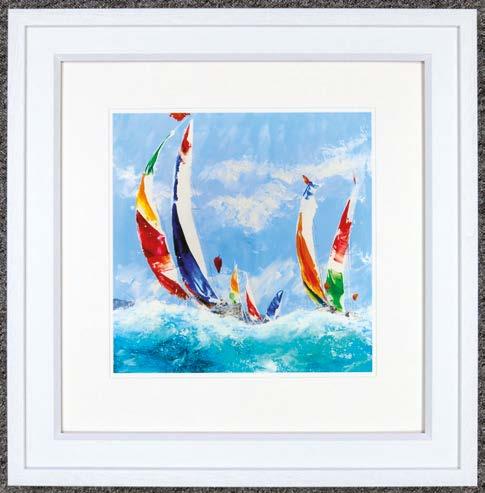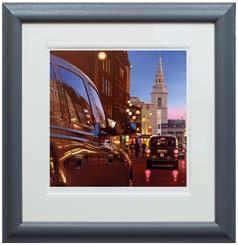
5 minute read
Masterclass
MIXING AND STACKING MOULDINGS A MASTERCLASS WITH JON PRICE GCF (APF)
I’ve just finished designing, constructing and filming the framing for three new Larson-Juhl ‘Master Class’ videos and I’m really excited by the potential results. I worked with the award winning video production agency, with whom I filmed the last series of videos. If you’ve seen those, you’ll know just how well they were put together (larsonjuhl.co.uk/haven/vids/jon-pricemasterclass). However, what really excites me about these new videos is the creative freedom I was given. Larson-Juhl provided me with three subjects ‘Mount design’, ‘Mixing Mouldings’ & ‘Anti-reflective & UV glass’. I was told to do whatever I wanted, use whatever materials I liked and not to hold back; a dream come true for any creative framer.
Advertisement
In truth, I was limited by two things; my imagination, and my belief that it’s essential to ensure that the techniques used are achievable by the vast majority of framers. Therefore, as well as producing each design on my usual equipment, I replicated each one using a manual mount cutter, a Morso and a foot-operated under pinner. So, although these videos are more inspirational than instructional, every concept is achievable by any framer with basic professional equipment.
Two of the new videos, ‘Mixing Mouldings’ and ‘Mount Design’ are completely design orientated. They each feature four different frame/mount designs for one piece of artwork. I started with simple concepts like treble mounts and stacking two mouldings before going on to the ‘3D double bevel shadow inlay mount’ and the seven moulding ‘mega stack’.
So, mixing mouldings, why bother? Adding width and depth - When I’m choosing framing with a customer, sometimes I find a moulding which is perfect – except for one factor. Often it’s too narrow or too shallow. This is where stacking comes in. By joining together two mouldings you can give the frame the additional width it needs or the extra depth required.
Adding colour - Imagine the same scenario, except this time you require a moulding with a mixture of colours that you don’t have on display, for example, a matt black with a gold sight edge. You could order samples of potentially suitable mouldings in the hope that your customer will come back once the samples have arrived or you could stack a matt black with a narrow gold, both of which you have on display, and at the same time offer your customer a unique, bespoke solution.
Increasing your options - No matter how many chevrons you have, it can sometimes be hard to find exactly the right moulding. Mixing mouldings massively increases your options. Once you start to look at which mouldings work together, you realise that the options are endless and your range of mouldings has trebled.
Changing your approach - It’s easy to fall into a routine of offering the same predictable design formula. How many design options do most framers offer on a daily basis? Single mount or double mount? Moulding A or moulding B? It’s so boring that I’m yawning just thinking about it! Don’t expect customers to help. They won’t think about mixing mouldings or multiple mounts unless we inspire them. Customers need to be led and educated by the framer. Of course, not every customer wants something different, but some do and they’re willing to pay for it. Matching ranges of the same finish enables you to emphasise more than one colour in a piece of artwork or to enhance colours with mouldings rather than mounts. It’s a different approach, but it’s one that I find inspiring and rewarding.
The rules The rules of mixing mouldings are, there aren’t any rules. However, different colour mouldings with the same or a similar profile work well together, as do profiles with the same finish and/ or colour. Different finishes don’t tend to work so well together.
So far, when mixing mouldings I have avoided combining them with elaborate mounts. I feel it overwhelms the artwork. However, I look forward to proving myself wrong quite soon.
How do you join mouldings? What equipment do you need? There are two standard ways of mixing mouldings. Placing different mouldings inside one another (stacking) as in picture 1, or joining different sections of the same profile together (mixing) as in picture 2.
Picture 1
Picture 2

Picture 3
To stack mouldings, cut and join the inner moulding first. The cutting length should be based on the mount or glass size, just like normal. Cut the second moulding using the outside length of the first moulding as your guide (see picture 3). Allow a couple of millimetres of expansion space. When you’ve cut and joined the second moulding check that it fits together with the first moulding satisfactorily and then join the two.
It’s important to make sure that even amounts of the inner moulding show under the rebate of the outer moulding when the two are joined. I use small squares of mount board to ensure even spacing (see picture 4).

Picture 4

You don’t need specific equipment to mix or stack mouldings. Some framers nail through the rebate of the inner moulding, others use framers points and staples or canvas offsets. You can even glue mouldings together. However, I recommend a Fletcher Flexible MultiMaster Gun (999000122). It’s quick, easy and designed for joining stacked frames. Mixing mouldings normally involves the same frame profile, so the pieces are cut and stacked as if they were the same moulding, although you will need to think about the final position of individual pieces during the joining process.
In my next 4walls article I’ll look at the design and thinking behind the four designs in the ‘Mixing and Stacking Mouldings’ video, as well as any additional techniques required in the process. In the meantime, grab some chevrons and start mixing those mouldings.
Jon Price GCF (APF) owns Handmade Framing & Gallery near Bude, North Cornwall as well as offering a consultancy service to professional, amateur and would-be framers. He is a member of the Fine Art Trade Guild’s Framing Standards and Qualifications Committee.
www.handmadepictureframing.co.uk










